The Limit of a Function and Limit Laws
Learning Objectives
- Using correct notation, describe the limit of a function.
- Use a table of values to estimate the limit of a function or to identify when the limit does not exist.
- Use a graph to estimate the limit of a function or to identify when the limit does not exist.
- Recognize the basic limit laws.
- Use the limit laws to evaluate the limit of a function.
- Evaluate the limit of a function by factoring.
- Use the limit laws to evaluate the limit of a polynomial or rational function.
- Evaluate the limit of a function by factoring or by using conjugates.
- Evaluate the limit of a function by using the squeeze theorem.
The concept of a limit or limiting process, essential to the understanding of calculus, has been around for thousands of years. In fact, early mathematicians used a limiting process to obtain better and better approximations of areas of circles. Yet, the formal definition of a limit—as we know and understand it today—did not appear until the late 19th century. We therefore begin our quest to understand limits, as our mathematical ancestors did, by using an intuitive approach. At the end of this chapter, armed with a conceptual understanding of limits, we examine the formal definition of a limit.
We begin our exploration of limits by taking a look at the graphs of the functions
which are shown in (Figure). In particular, let’s focus our attention on the behavior of each graph at and around [latex]x=2[/latex].
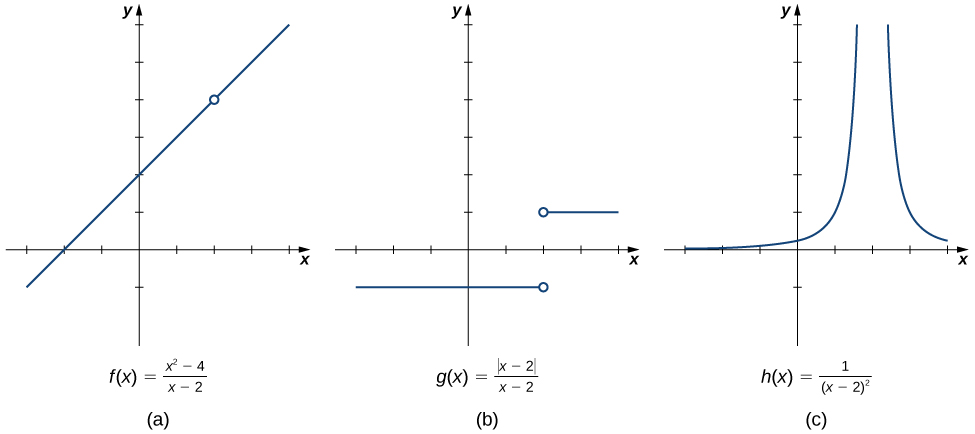 Figure 1. These graphs show the behavior of three different functions around [latex]x=2[/latex].
Figure 1. These graphs show the behavior of three different functions around [latex]x=2[/latex].Each of the three functions is undefined at [latex]x=2[/latex], but if we make this statement and no other, we give a very incomplete picture of how each function behaves in the vicinity of [latex]x=2[/latex]. To express the behavior of each graph in the vicinity of 2 more completely, we need to introduce the concept of a limit.
Intuitive Definition of a Limit
Let’s first take a closer look at how the function [latex]f(x)=(x^2-4)/(x-2)[/latex] behaves around [latex]x=2[/latex] in (Figure). As the values of [latex]x[/latex] approach 2 from either side of 2, the values of [latex]y=f(x)[/latex] approach 4. Mathematically, we say that the limit of [latex]f(x)[/latex] as [latex]x[/latex] approaches 2 is 4. Symbolically, we express this limit as
From this very brief informal look at one limit, let’s start to develop an intuitive definition of the limit. We can think of the limit of a function at a number [latex]a[/latex] as being the one real number [latex]L[/latex] that the functional values approach as the [latex]x[/latex]-values approach [latex]a[/latex], provided such a real number [latex]L[/latex] exists. Stated more carefully, we have the following definition:
Definition
Let [latex]f(x)[/latex] be a function defined at all values in an open interval containing [latex]a[/latex], with the possible exception of [latex]a[/latex] itself, and let [latex]L[/latex] be a real number. If all values of the function [latex]f(x)[/latex] approach the real number [latex]L[/latex] as the values of [latex]x(\ne a)[/latex] approach the number [latex]a[/latex], then we say that the limit of [latex]f(x)[/latex] as [latex]x[/latex] approaches [latex]a[/latex] is [latex]L[/latex]. (More succinct, as [latex]x[/latex] gets closer to [latex]a[/latex], [latex]f(x)[/latex] gets closer and stays close to [latex]L[/latex].) Symbolically, we express this idea as
We can estimate limits by constructing tables of functional values and by looking at their graphs. This process is described in the following Problem-Solving Strategy.
Problem-Solving Strategy: Evaluating a Limit Using a Table of Functional Values
- To evaluate [latex]\underset{x\to a}{\lim}f(x)[/latex], we begin by completing a table of functional values. We should choose two sets of [latex]x[/latex]-values—one set of values approaching [latex]a[/latex] and less than [latex]a[/latex], and another set of values approaching [latex]a[/latex] and greater than [latex]a[/latex]. (Figure) demonstrates what your tables might look like.
Table of Functional Values for [latex]\underset{x\to a}{\lim}f(x)[/latex] [latex]x[/latex] [latex]f(x)[/latex] [latex]x[/latex] [latex]f(x)[/latex] [latex]a-0.1[/latex] [latex]f(a-0.1)[/latex] [latex]a+0.1[/latex] [latex]f(a+0.1)[/latex] [latex]a-0.01[/latex] [latex]f(a-0.01)[/latex] [latex]a+0.01[/latex] [latex]f(a+0.01)[/latex] [latex]a-0.001[/latex] [latex]f(a-0.001)[/latex] [latex]a+0.001[/latex] [latex]f(a+0.001)[/latex] [latex]a-0.0001[/latex] [latex]f(a-0.0001)[/latex] [latex]a+0.0001[/latex] [latex]f(a+0.0001)[/latex] Use additional values as necessary. Use additional values as necessary. - Next, let’s look at the values in each of the [latex]f(x)[/latex] columns and determine whether the values seem to be approaching a single value as we move down each column. In our columns, we look at the sequence [latex]f(a-0.1), \, f(a-0.01), \, f(a-0.001), \, f(a-0.0001),[/latex] and so on, and [latex]f(a+0.1), \, f(a+0.01), \, f(a+0.001), \, f(a+0.0001)[/latex] and so on. (Note: Although we have chosen the [latex]x[/latex]-values [latex]a \pm 0.1, \, a \pm 0.01, \, a \pm 0.001, \, a \pm 0.0001[/latex], and so forth, and these values will probably work nearly every time, on very rare occasions we may need to modify our choices.)
- If both columns approach a common [latex]y[/latex]-value [latex]L[/latex], we state [latex]\underset{x\to a}{\lim}f(x)=L[/latex]. We can use the following strategy to confirm the result obtained from the table or as an alternative method for estimating a limit.
- Using a graphing calculator or computer software that allows us graph functions, we can plot the function [latex]f(x)[/latex], making sure the functional values of [latex]f(x)[/latex] for [latex]x[/latex]-values near [latex]a[/latex] are in our window. We can use the trace feature to move along the graph of the function and watch the [latex]y[/latex]-value readout as the [latex]x[/latex]-values approach [latex]a[/latex]. If the [latex]y[/latex]-values approach [latex]L[/latex] as our [latex]x[/latex]-values approach [latex]a[/latex] from both directions, then [latex]\underset{x\to a}{\lim}f(x)=L[/latex]. We may need to zoom in on our graph and repeat this process several times.
We apply this Problem-Solving Strategy to compute a limit in (Figure).
Evaluating a Limit Using a Table of Functional Values 1
Evaluate [latex]\underset{x\to 0}{\lim}\frac{\sin x}{x}[/latex] using a table of functional values.
Answer: We have calculated the values of [latex]f(x)=(\sin x)/x[/latex] for the values of [latex]x[/latex] listed in (Figure).
| [latex]x[/latex] | [latex]\frac{\sin x}{x}[/latex] | [latex]x[/latex] | [latex]\frac{\sin x}{x}[/latex] | |
|---|---|---|---|---|
| −0.1 | 0.998334166468 | 0.1 | 0.998334166468 | |
| −0.01 | 0.999983333417 | 0.01 | 0.999983333417 | |
| −0.001 | 0.999999833333 | 0.001 | 0.999999833333 | |
| −0.0001 | 0.999999998333 | 0.0001 | 0.999999998333 |
Note: The values in this table were obtained using a calculator and using all the places given in the calculator output.
As we read down each [latex]\frac{\sin x}{x}[/latex] column, we see that the values in each column appear to be approaching one. Thus, it is fairly reasonable to conclude that [latex]\underset{x\to 0}{\lim}\frac{\sin x}{x}=1[/latex]. A calculator-or computer-generated graph of [latex]f(x)=\frac{\sin x}{x}[/latex] would be similar to that shown in (Figure), and it confirms our estimate.
![A graph of f(x) = sin(x)/x over the interval [-6, 6]. The curving function has a y intercept at x=0 and x intercepts at y=pi and y=-pi.](https://s3-us-west-2.amazonaws.com/courses-images/wp-content/uploads/sites/2332/2018/01/11202852/CNX_Calc_Figure_02_02_003.jpg) Figure 2. The graph of [latex]f(x)=(\sin x)/x[/latex] confirms the estimate from the table.
Figure 2. The graph of [latex]f(x)=(\sin x)/x[/latex] confirms the estimate from the table.Evaluating a Limit Using a Table of Functional Values 2
Evaluate [latex]\underset{x\to 4}{\lim}\frac{\sqrt{x}-2}{x-4}[/latex] using a table of functional values.
Answer:
As before, we use a table—in this case, (Figure)—to list the values of the function for the given values of [latex]x[/latex].
| [latex]x[/latex] | [latex]\frac{\sqrt{x}-2}{x-4}[/latex] | [latex]x[/latex] | [latex]\frac{\sqrt{x}-2}{x-4}[/latex] | |
|---|---|---|---|---|
| 3.9 | 0.251582341869 | 4.1 | 0.248456731317 | |
| 3.99 | 0.25015644562 | 4.01 | 0.24984394501 | |
| 3.999 | 0.250015627 | 4.001 | 0.249984377 | |
| 3.9999 | 0.250001563 | 4.0001 | 0.249998438 | |
| 3.99999 | 0.25000016 | 4.00001 | 0.24999984 |
After inspecting this table, we see that the functional values less than 4 appear to be decreasing toward 0.25 whereas the functional values greater than 4 appear to be increasing toward 0.25. We conclude that [latex]\underset{x\to 4}{\lim}\frac{\sqrt{x}-2}{x-4}=0.25[/latex]. We confirm this estimate using the graph of [latex]f(x)=\frac{\sqrt{x}-2}{x-4}[/latex] shown in (Figure).
![A graph of the function f(x) = (sqrt(x) – 2 ) / (x-4) over the interval [0,8]. There is an open circle on the function at x=4. The function curves asymptotically towards the x axis and y axis in quadrant one.](https://s3-us-west-2.amazonaws.com/courses-images/wp-content/uploads/sites/2332/2018/01/11202855/CNX_Calc_Figure_02_02_004.jpg) Figure 3. The graph of [latex]f(x)=\frac{\sqrt{x}-2}{x-4}[/latex] confirms the estimate from the table.
Figure 3. The graph of [latex]f(x)=\frac{\sqrt{x}-2}{x-4}[/latex] confirms the estimate from the table.Estimate [latex]\underset{x\to 1}{\lim}\frac{\frac{1}{x}-1}{x-1}[/latex] using a table of functional values. Use a graph to confirm your estimate.
Answer:
[latex]\underset{x\to 1}{\lim}\frac{\frac{1}{x}-1}{x-1}=-1[/latex]
At this point, we see from (Figure) and (Figure) that it may be just as easy, if not easier, to estimate a limit of a function by inspecting its graph as it is to estimate the limit by using a table of functional values. In (Figure), we evaluate a limit exclusively by looking at a graph rather than by using a table of functional values.
Evaluating a Limit Using a Graph
For [latex]g(x)[/latex] shown in (Figure), evaluate [latex]\underset{x\to -1}{\lim}g(x)[/latex].
 Figure 4. The graph of [latex]g(x)[/latex] includes one value not on a smooth curve.
Figure 4. The graph of [latex]g(x)[/latex] includes one value not on a smooth curve.Answer:
Despite the fact that [latex]g(-1)=4[/latex], as the [latex]x[/latex]-values approach −1 from either side, the [latex]g(x)[/latex] values approach 3. Therefore, [latex]\underset{x\to -1}{\lim}g(x)=3[/latex]. Note that we can determine this limit without even knowing the algebraic expression of the function.
Based on (Figure), we make the following observation: It is possible for the limit of a function to exist at a point, and for the function to be defined at this point, but the limit of the function and the value of the function at the point may be different.
Use the graph of [latex]h(x)[/latex] in (Figure) to evaluate [latex]\underset{x\to 2}{\lim}h(x)[/latex], if possible.
![A graph of the function h(x), which is a parabola graphed over [-2.5, 5]. There is an open circle where the vertex should be at the point (2,-1).](https://s3-us-west-2.amazonaws.com/courses-images/wp-content/uploads/sites/2332/2018/01/11202902/CNX_Calc_Figure_02_02_007.jpg) Figure 5. The graph of [latex]h(x)[/latex] consists of a smooth graph with a single removed point at [latex]x=2[/latex].
Figure 5. The graph of [latex]h(x)[/latex] consists of a smooth graph with a single removed point at [latex]x=2[/latex].Answer:
[latex]\underset{x\to 2}{\lim}h(x)=-1[/latex].
Hint
What [latex]y[/latex]-value does the function approach as the [latex]x[/latex]-values approach 2?
Looking at a table of functional values or looking at the graph of a function provides us with useful insight into the value of the limit of a function at a given point. However, these techniques rely too much on guesswork. We eventually need to develop alternative methods of evaluating limits. These new methods are more algebraic in nature and we explore them in the next section; however, at this point we introduce two special limits that are foundational to the techniques to come.
Two Important Limits
Let [latex]a[/latex] be a real number and [latex]c[/latex] be a constant.
-
[latex]\underset{x\to a}{\lim}x=a[/latex]
-
[latex]\underset{x\to a}{\lim}c=c[/latex]
We can make the following observations about these two limits.
- For the first limit, observe that as [latex]x[/latex] approaches [latex]a[/latex], so does [latex]f(x)[/latex], because [latex]f(x)=x[/latex]. Consequently, [latex]\underset{x\to a}{\lim}x=a[/latex].
- For the second limit, consider (Figure).
| [latex]x[/latex] | [latex]f(x)=c[/latex] | [latex]x[/latex] | [latex]f(x)=c[/latex] | |
|---|---|---|---|---|
| [latex]a-0.1[/latex] | [latex]c[/latex] | [latex]a+0.1[/latex] | [latex]c[/latex] | |
| [latex]a-0.01[/latex] | [latex]c[/latex] | [latex]a+0.01[/latex] | [latex]c[/latex] | |
| [latex]a-0.001[/latex] | [latex]c[/latex] | [latex]a+0.001[/latex] | [latex]c[/latex] | |
| [latex]a-0.0001[/latex] | [latex]c[/latex] | [latex]a+0.0001[/latex] | [latex]c[/latex] |
Observe that for all values of [latex]x[/latex] (regardless of whether they are approaching [latex]a[/latex]), the values [latex]f(x)[/latex] remain constant at [latex]c[/latex]. We have no choice but to conclude [latex]\underset{x\to a}{\lim}c=c[/latex].
The Existence of a Limit
As we consider the limit in the next example, keep in mind that for the limit of a function to exist at a point, the functional values must approach a single real-number value at that point. If the functional values do not approach a single value, then the limit does not exist.
Evaluating a Limit That Fails to Exist
Evaluate [latex]\underset{x\to 0}{\lim} \sin (1/x)[/latex] using a table of values.
Answer:
(Figure) lists values for the function [latex] \sin (1/x)[/latex] for the given values of [latex]x[/latex].
| [latex]x[/latex] | [latex] \sin (\frac{1}{x})[/latex] | [latex]x[/latex] | [latex] \sin (\frac{1}{x})[/latex] | |
|---|---|---|---|---|
| −0.1 | 0.544021110889 | 0.1 | −0.544021110889 | |
| −0.01 | 0.50636564111 | 0.01 | −0.50636564111 | |
| −0.001 | −0.8268795405312 | 0.001 | 0.826879540532 | |
| −0.0001 | 0.305614388888 | 0.0001 | −0.305614388888 | |
| −0.00001 | −0.035748797987 | 0.00001 | 0.035748797987 | |
| −0.000001 | 0.349993504187 | 0.000001 | −0.349993504187 |
After examining the table of functional values, we can see that the [latex]y[/latex]-values do not seem to approach any one single value. It appears the limit does not exist. Before drawing this conclusion, let’s take a more systematic approach. Take the following sequence of [latex]x[/latex]-values approaching 0:
The corresponding [latex]y[/latex]-values are
At this point we can indeed conclude that [latex]\underset{x\to 0}{\lim} \sin (1/x)[/latex] does not exist. (Mathematicians frequently abbreviate “does not exist” as DNE. Thus, we would write [latex]\underset{x\to 0}{\lim} \sin (1/x)[/latex] DNE.) The graph of [latex]f(x)= \sin (1/x)[/latex] is shown in (Figure) and it gives a clearer picture of the behavior of [latex] \sin (1/x)[/latex] as [latex]x[/latex] approaches 0. You can see that [latex] \sin (1/x)[/latex] oscillates ever more wildly between −1 and 1 as [latex]x[/latex] approaches 0.
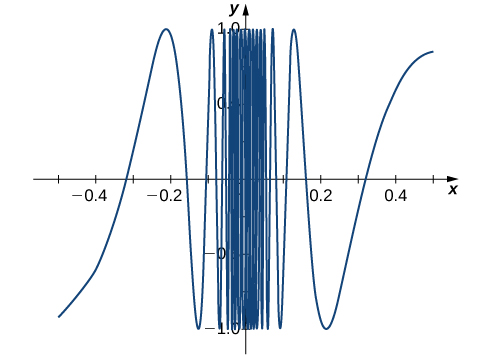 Figure 6. The graph of [latex]f(x)= \sin (1/x)[/latex] oscillates rapidly between −1 and 1 as x approaches 0.
Figure 6. The graph of [latex]f(x)= \sin (1/x)[/latex] oscillates rapidly between −1 and 1 as x approaches 0.Use a table of functional values to evaluate [latex]\underset{x\to 2}{\lim}\frac{|x^2-4|}{x-2}[/latex], if possible.
Answer:
[latex]\underset{x\to 2}{\lim}\frac{|x^2-4|}{x-2}[/latex] does not exist.
Hint
Use [latex]x[/latex]-values 1.9, 1.99, 1.999, 1.9999, 1.9999 and 2.1, 2.01, 2.001, 2.0001, 2.00001 in your table.
In the beginning of this section, we evaluated limits by looking at graphs or by constructing a table of values. Now we establish laws for calculating limits and learn how to apply these laws. In the Student Project at the end of this section, you have the opportunity to apply these limit laws to derive the formula for the area of a circle by adapting a method devised by the Greek mathematician Archimedes. We begin by restating two useful limit results from the previous section. These two results, together with the limit laws, serve as a foundation for calculating many limits.
Evaluating Limits with the Limit Laws
The first two limit laws were stated in (Figure) and we repeat them here. These basic results, together with the other limit laws, allow us to evaluate limits of many algebraic functions.
Basic Limit Results
For any real number [latex]a[/latex] and any constant [latex]c[/latex],
-
[latex]\underset{x\to a}{\lim}x=a[/latex]
-
[latex]\underset{x\to a}{\lim}c=c[/latex]
Evaluating a Basic Limit
Evaluate each of the following limits using (Figure).
- [latex]\underset{x\to 2}{\lim}x[/latex]
- [latex]\underset{x\to 2}{\lim}5[/latex]
Answer:
- The limit of [latex]x[/latex] as [latex]x[/latex] approaches [latex]a[/latex] is [latex]a[/latex]: [latex]\underset{x\to 2}{\lim}x=2[/latex].
- The limit of a constant is that constant: [latex]\underset{x\to 2}{\lim}5=5[/latex].
We now take a look at the limit laws, the individual properties of limits. The proofs that these laws hold are omitted here.
Limit Laws
Let [latex]f(x)[/latex] and [latex]g(x)[/latex] be defined for all [latex]x\ne a[/latex] over some open interval containing [latex]a[/latex]. Assume that [latex]L[/latex] and [latex]M[/latex] are real numbers such that [latex]\underset{x\to a}{\lim}f(x)=L[/latex] and [latex]\underset{x\to a}{\lim}g(x)=M[/latex]. Let [latex]c[/latex] be a constant. Then, each of the following statements holds:
Sum law for limits: [latex]\underset{x\to a}{\lim}(f(x)+g(x))=\underset{x\to a}{\lim}f(x)+\underset{x\to a}{\lim}g(x)=L+M[/latex]
Difference law for limits: [latex]\underset{x\to a}{\lim}(f(x)-g(x))=\underset{x\to a}{\lim}f(x)-\underset{x\to a}{\lim}g(x)=L-M[/latex]
Constant multiple law for limits: [latex]\underset{x\to a}{\lim}cf(x)=c \cdot \underset{x\to a}{\lim}f(x)=cL[/latex]
Product law for limits: [latex]\underset{x\to a}{\lim}(f(x) \cdot g(x))=\underset{x\to a}{\lim}f(x) \cdot \underset{x\to a}{\lim}g(x)=L \cdot M[/latex]
Quotient law for limits: [latex]\underset{x\to a}{\lim}\frac{f(x)}{g(x)}=\frac{\underset{x\to a}{\lim}f(x)}{\underset{x\to a}{\lim}g(x)}=\frac{L}{M}[/latex] for [latex]M\ne 0[/latex]
Power law for limits: [latex]\underset{x\to a}{\lim}(f(x))^n=(\underset{x\to a}{\lim}f(x))^n=L^n[/latex] for every positive integer [latex]n[/latex].
Root law for limits: [latex]\underset{x\to a}{\lim}\sqrt[n]{f(x)}=\sqrt[n]{\underset{x\to a}{\lim}f(x)}=\sqrt[n]{L}[/latex] for all [latex]L[/latex] if [latex]n[/latex] is odd and for [latex]L\ge 0[/latex] if [latex]n[/latex] is even.
We now practice applying these limit laws to evaluate a limit.
Evaluating a Limit Using Limit Laws
Use the limit laws to evaluate [latex]\underset{x\to -3}{\lim}(4x+2)[/latex].
Answer:
Let’s apply the limit laws one step at a time to be sure we understand how they work. We need to keep in mind the requirement that, at each application of a limit law, the new limits must exist for the limit law to be applied.
[latex]\begin{array}{ccccc}\underset{x\to -3}{\lim}(4x+2)\hfill & =\underset{x\to -3}{\lim}4x+\underset{x\to -3}{\lim}2\hfill & & & \text{Apply the sum law.}\hfill \\ & =4 \cdot \underset{x\to -3}{\lim}x+\underset{x\to -3}{\lim}2\hfill & & & \text{Apply the constant multiple law.}\hfill \\ & =4 \cdot (-3)+2=-10\hfill & & & \text{Apply the basic limit results and simplify.}\hfill \end{array}[/latex]
Using Limit Laws Repeatedly
Answer:
To find this limit, we need to apply the limit laws several times. Again, we need to keep in mind that as we rewrite the limit in terms of other limits, each new limit must exist for the limit law to be applied.
[latex-display]\begin{array}{ccccc}\\ \\ \underset{x\to 2}{\lim}\large \frac{2x^2-3x+1}{x^3+4} & = \large \frac{\underset{x\to 2}{\lim}(2x^2-3x+1)}{\underset{x\to 2}{\lim}(x^3+4)} & & & \text{Apply the quotient law, making sure that} \, 2^3+4\ne 0 \\ & = \large \frac{2 \cdot \underset{x\to 2}{\lim}x^2-3 \cdot \underset{x\to 2}{\lim}x+\underset{x\to 2}{\lim}1}{\underset{x\to 2}{\lim}x^3+\underset{x\to 2}{\lim}4} & & & \text{Apply the sum law and constant multiple law.} \\ & = \large \frac{2 \cdot (\underset{x\to 2}{\lim}x)^2-3 \cdot \underset{x\to 2}{\lim}x+\underset{x\to 2}{\lim}1}{(\underset{x\to 2}{\lim}x)^3+\underset{x\to 2}{\lim}4} & & & \text{Apply the power law.} \\ & = \large \frac{2(4)-3(2)+1}{2^3+4}=\frac{1}{4} & & & \text{Apply the basic limit laws and simplify.} \end{array}[/latex-display]Use the limit laws to evaluate [latex]\underset{x\to 6}{\lim}(2x-1)\sqrt{x+4}[/latex]. In each step, indicate the limit law applied.
Answer:
[latex]11\sqrt{10}[/latex]
Hint
Begin by applying the product law.
Limits of Polynomial and Rational Functions
By now you have probably noticed that, in each of the previous examples, it has been the case that [latex]\underset{x\to a}{\lim}f(x)=f(a)[/latex]. This is not always true, but it does hold for all polynomials for any choice of [latex]a[/latex] and for all rational functions at all values of [latex]a[/latex] for which the rational function is defined.
Limits of Polynomial and Rational Functions
Let [latex]p(x)[/latex] and [latex]q(x)[/latex] be polynomial functions. Let [latex]a[/latex] be a real number. Then,
To see that this theorem holds, consider the polynomial [latex]p(x)=c_nx^n+c_{n-1}x^{n-1}+\cdots +c_1x+c_0[/latex]. By applying the sum, constant multiple, and power laws, we end up with
It now follows from the quotient law that if [latex]p(x)[/latex] and [latex]q(x)[/latex] are polynomials for which [latex]q(a)\ne 0[/latex], then
(Figure) applies this result.
Evaluating a Limit of a Rational Function
Evaluate the [latex]\underset{x\to 3}{\lim}\frac{2x^2-3x+1}{5x+4}[/latex].
Answer:
Since 3 is in the domain of the rational function [latex]f(x)=\frac{2x^2-3x+1}{5x+4}[/latex], we can calculate the limit by substituting 3 for [latex]x[/latex] into the function. Thus,
Evaluate [latex]\underset{x\to -2}{\lim}(3x^3-2x+7)[/latex].
Answer:
−13
Hint
Use (Figure)
Additional Limit Evaluation Techniques
As we have seen, we may evaluate easily the limits of polynomials and limits of some (but not all) rational functions by direct substitution. However, as we saw in the introductory section on limits, it is certainly possible for [latex]\underset{x\to a}{\lim}f(x)[/latex] to exist when [latex]f(a)[/latex] is undefined. The following observation allows us to evaluate many limits of this type:
If for all [latex]x\ne a, \, f(x)=g(x)[/latex] over some open interval containing [latex]a[/latex], then [latex]\underset{x\to a}{\lim}f(x)=\underset{x\to a}{\lim}g(x)[/latex].
To understand this idea better, consider the limit [latex]\underset{x\to 1}{\lim}\frac{x^2-1}{x-1}[/latex].
The function
and the function [latex]g(x)=x+1[/latex] are identical for all values of [latex]x\ne 1.[/latex] The graphs of these two functions are shown in (Figure).
 Figure 1. The graphs of [latex]f(x)[/latex] and [latex]g(x)[/latex] are identical for all [latex]x\ne 1[/latex]. Their limits at 1 are equal.
Figure 1. The graphs of [latex]f(x)[/latex] and [latex]g(x)[/latex] are identical for all [latex]x\ne 1[/latex]. Their limits at 1 are equal.We see that
The limit has the form [latex]\underset{x\to a}{\lim}\frac{f(x)}{g(x)}[/latex], where [latex]\underset{x\to a}{\lim}f(x)=0[/latex] and [latex]\underset{x\to a}{\lim}g(x)=0[/latex]. (In this case, we say that [latex]f(x)/g(x)[/latex] has the indeterminate form 0/0.) The following Problem-Solving Strategy provides a general outline for evaluating limits of this type.
Problem-Solving Strategy: Calculating a Limit When [latex]f(x)/g(x)[/latex] has the Indeterminate Form 0/0
- First, we need to make sure that our function has the appropriate form and cannot be evaluated immediately using the limit laws.
- We then need to find a function that is equal to [latex]h(x)=f(x)/g(x)[/latex] for all [latex]x\ne a[/latex] over some interval containing [latex]a[/latex]. To do this, we may need to try one or more of the following steps:
- If [latex]f(x)[/latex] and [latex]g(x)[/latex] are polynomials, we should factor each function and cancel out any common factors.
- If the numerator or denominator contains a difference involving a square root, we should try multiplying the numerator and denominator by the conjugate of the expression involving the square root.
- If [latex]f(x)/g(x)[/latex] is a complex fraction, we begin by simplifying it.
- Last, we apply the limit laws.
The next examples demonstrate the use of this Problem-Solving Strategy. (Figure) illustrates the factor-and-cancel technique; (Figure) shows multiplying by a conjugate. In (Figure), we look at simplifying a complex fraction.
Evaluating a Limit by Factoring and Canceling
Evaluate [latex]\underset{x\to 3}{\lim}\frac{x^2-3x}{2x^2-5x-3}[/latex].
Answer:
Step 1. The function [latex]f(x)=\frac{x^2-3x}{2x^2-5x-3}[/latex] is undefined for [latex]x=3[/latex]. In fact, if we substitute 3 into the function we get 0/0, which is undefined. Factoring and canceling is a good strategy:
Step 2. For all [latex]x\ne 3, \, \frac{x^2-3x}{2x^2-5x-3}=\frac{x}{2x+1}[/latex]. Therefore,
Step 3. Evaluate using the limit laws:
Evaluate [latex]\underset{x\to -3}{\lim}\frac{x^2+4x+3}{x^2-9}[/latex].
Answer:
[latex]\frac{1}{3}[/latex]
Hint
Follow the steps in the Problem-Solving Strategy and (Figure).
Evaluating a Limit by Multiplying by a Conjugate
Evaluate [latex]\underset{x\to -1}{\lim}\frac{\sqrt{x+2}-1}{x+1}[/latex].
Answer:
Step 1.[latex]\frac{\sqrt{x+2}-1}{x+1}[/latex] has the form 0/0 at −1. Let’s begin by multiplying by [latex]\sqrt{x+2}+1[/latex], the conjugate of [latex]\sqrt{x+2}-1[/latex], on the numerator and denominator:
Step 2. We then multiply out the numerator. We don’t multiply out the denominator because we are hoping that the [latex](x+1)[/latex] in the denominator cancels out in the end:
Step 3. Then we cancel:
Step 4. Last, we apply the limit laws:
Evaluate [latex]\underset{x\to 5}{\lim}\frac{\sqrt{x-1}-2}{x-5}[/latex].
Answer:
[latex]\frac{1}{4}[/latex]
Hint
Follow the steps in the Problem-Solving Strategy and (Figure).
Evaluating a Limit by Simplifying a Complex Fraction
Evaluate [latex]\underset{x\to 1}{\lim}\frac{\frac{1}{x+1}-\frac{1}{2}}{x-1}[/latex].
Answer:
Step 1. [latex]\frac{\frac{1}{x+1}-\frac{1}{2}}{x-1}[/latex] has the form 0/0 at 1. We simplify the algebraic fraction by multiplying by [latex]2(x+1)/2(x+1)[/latex]:
Step 2. Next, we multiply through the numerators. Do not multiply the denominators because we want to be able to cancel the factor [latex](x-1)[/latex]:
Step 3. Then, we simplify the numerator:
Step 4. Now we factor out −1 from the numerator:
Step 5. Then, we cancel the common factors of [latex](x-1)[/latex]:
Step 6. Last, we evaluate using the limit laws:
Evaluate [latex]\underset{x\to -3}{\lim}\frac{\frac{1}{x+2}+1}{x+3}[/latex].
Answer:
−1
Hint
Follow the steps in the Problem-Solving Strategy and (Figure).
(Figure) does not fall neatly into any of the patterns established in the previous examples. However, with a little creativity, we can still use these same techniques.
Evaluating a Limit When the Limit Laws Do Not Apply
Evaluate [latex]\underset{x\to 0}{\lim}\big(\frac{1}{x}+\frac{5}{x(x-5)}\big)[/latex].
Answer:
Both [latex]1/x[/latex] and [latex]5/x(x-5)[/latex] fail to have a limit at zero. Since neither of the two functions has a limit at zero, we cannot apply the sum law for limits; we must use a different strategy. In this case, we find the limit by performing addition and then applying one of our previous strategies. Observe that
Thus,
Evaluate [latex]\underset{x\to 3}{\lim}(\frac{1}{x-3}-\frac{4}{x^2-2x-3})[/latex].
Answer:
[latex]\frac{1}{4}[/latex]
Hint
Use the same technique as (Figure). Don’t forget to factor [latex]x^2-2x-3[/latex] before getting a common denominator.
The Squeeze Theorem
The techniques we have developed thus far work very well for algebraic functions, but we are still unable to evaluate limits of very basic trigonometric functions. The next theorem, called the squeeze theorem, proves very useful for establishing basic trigonometric limits. This theorem allows us to calculate limits by “squeezing” a function, with a limit at a point [latex]a[/latex] that is unknown, between two functions having a common known limit at [latex]a[/latex]. (Figure) illustrates this idea.
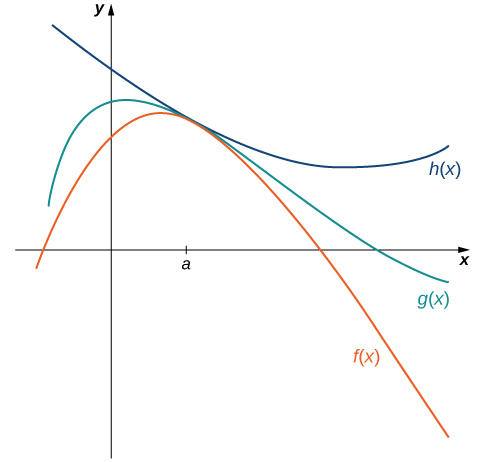 Figure 4. The Squeeze Theorem applies when [latex]f(x)\le g(x)\le h(x)[/latex] and [latex]\underset{x\to a}{\lim}f(x)=\underset{x\to a}{\lim}h(x)[/latex].
Figure 4. The Squeeze Theorem applies when [latex]f(x)\le g(x)\le h(x)[/latex] and [latex]\underset{x\to a}{\lim}f(x)=\underset{x\to a}{\lim}h(x)[/latex].The Squeeze Theorem
Let [latex]f(x), \, g(x)[/latex], and [latex]h(x)[/latex] be defined for all [latex]x\ne a[/latex] over an open interval containing [latex]a[/latex]. If
for all [latex]x\ne a[/latex] in an open interval containing [latex]a[/latex] and
where [latex]L[/latex] is a real number, then [latex]\underset{x\to a}{\lim}g(x)=L[/latex].
Applying the Squeeze Theorem
Apply the Squeeze Theorem to evaluate [latex]\underset{x\to 0}{\lim}x \cos x[/latex].
Answer:
Because [latex]-1\le \cos x\le 1[/latex] for all [latex]x[/latex], we have [latex]-x\le x \cos x\le x[/latex] for [latex]x\ge 0[/latex] and [latex]-x\ge xcosx\ge x[/latex] for [latex]x\le 0[/latex] (if [latex]x[/latex] is negative the direction of the inequalities changes when we multiply). Since [latex]\underset{x\to 0}{\lim}(-x)=0=\underset{x\to 0}{\lim}x[/latex], from the Squeeze Theorem we obtain [latex]\underset{x\to 0}{\lim}x \cos x=0[/latex]. The graphs of [latex]f(x)=-x, \, g(x)=x \cos x[/latex], and [latex]h(x)=x[/latex] are shown in (Figure).
 Figure 5. The graphs of [latex]f(x), \, g(x)[/latex], and [latex]h(x)[/latex] are shown around the point [latex]x=0[/latex].
Figure 5. The graphs of [latex]f(x), \, g(x)[/latex], and [latex]h(x)[/latex] are shown around the point [latex]x=0[/latex].Use the Squeeze Theorem to evaluate [latex]\underset{x\to 0}{\lim}x^2 \sin \frac{1}{x}[/latex].
Answer:
0
Hint
Use the fact that [latex]-x^2\le x^2 \sin (1/x)\le x^2[/latex] to help you find two functions such that [latex]x^2 \sin (1/x)[/latex] is squeezed between them.
Deriving the Formula for the Area of a Circle
Some of the geometric formulas we take for granted today were first derived by methods that anticipate some of the methods of calculus. The Greek mathematician Archimedes (ca. 287−212 BCE) was particularly inventive, using polygons inscribed within circles to approximate the area of the circle as the number of sides of the polygon increased. He never came up with the idea of a limit, but we can use this idea to see what his geometric constructions could have predicted about the limit.
We can estimate the area of a circle by computing the area of an inscribed regular polygon. Think of the regular polygon as being made up of [latex]n[/latex] triangles. By taking the limit as the vertex angle of these triangles goes to zero, you can obtain the area of the circle. To see this, carry out the following steps:
- Express the height [latex]h[/latex] and the base [latex]b[/latex] of the isosceles triangle in (Figure) in terms of [latex]\theta[/latex] and [latex]r[/latex].
 Figure 8.
Figure 8. - Using the expressions that you obtained in step 1, express the area of the isosceles triangle in terms of [latex]\theta[/latex] and [latex]r[/latex]. (Substitute [latex](1/2)\sin \theta[/latex] for [latex]\sin(\theta/2) \cos(\theta/2)[/latex] in your expression.)
- If an [latex]n[/latex]-sided regular polygon is inscribed in a circle of radius [latex]r[/latex], find a relationship between [latex]\theta[/latex] and [latex]n[/latex]. Solve this for [latex]n[/latex]. Keep in mind there are [latex]2\pi[/latex] radians in a circle. (Use radians, not degrees.)
- Find an expression for the area of the [latex]n[/latex]-sided polygon in terms of [latex]r[/latex] and [latex]\theta[/latex].
- To find a formula for the area of the circle, find the limit of the expression in step 4 as [latex]\theta[/latex] goes to zero. (Hint: [latex]\underset{\theta \to 0}{\lim}\frac{(\sin \theta)}{\theta}=1[/latex].)
The technique of estimating areas of regions by using polygons is revisited in Introduction to Integration.
Key Concepts
- A table of values or graph may be used to estimate a limit.
- If the limit of a function at a point does not exist, it is still possible that the limits from the left and right at that point may exist.
- If the limits of a function from the left and right exist and are equal, then the limit of the function is that common value.
- We may use limits to describe infinite behavior of a function at a point.
- The limit laws allow us to evaluate limits of functions without having to go through step-by-step processes each time.
- For polynomials and rational functions, [latex]\underset{x\to a}{\lim}f(x)=f(a)[/latex].
- You can evaluate the limit of a function by factoring and canceling, by multiplying by a conjugate, or by simplifying a complex fraction.
- The Squeeze Theorem allows you to find the limit of a function if the function is always greater than one function and less than another function with limits that are known.
Key Equations
- Intuitive Definition of the Limit [latex]\underset{x\to a}{\lim}f(x)=L[/latex]
- Basic Limit Results [latex-display]\underset{x\to a}{\lim}x=a[/latex-display] [latex]\underset{x\to a}{\lim}c=c[/latex]
- Important Limits [latex-display]\underset{\theta \to 0}{\lim} \sin \theta =0[/latex-display] [latex]\underset{\theta \to 0}{\lim} \cos \theta =1[/latex]
For the following exercises, consider the function [latex]f(x)=\frac{x^2-1}{|x-1|}[/latex].
| [latex]x[/latex] | [latex]f(x)[/latex] | [latex]x[/latex] | [latex]f(x)[/latex] |
|---|---|---|---|
| 0.9 | a. | 1.1 | e. |
| 0.99 | b. | 1.01 | f. |
| 0.999 | c. | 1.001 | g. |
| 0.9999 | d. | 1.0001 | h. |
2. What do your results in the preceding exercise indicate about the two-sided limit [latex]\underset{x\to 1}{\lim}f(x)[/latex]? Explain your response.
Answer:
[latex]\underset{x\to 1}{\lim}f(x)[/latex] does not exist because [latex]\underset{x\to 1^-}{\lim}f(x)=-2 \ne \underset{x\to 1^+}{\lim}f(x)=2[/latex].
3. [T] Make a table showing the values of [latex]f[/latex] for [latex]x=-0.01, \, -0.001, \, -0.0001, \, -0.00001[/latex] and for [latex]x=0.01, \, 0.001, \, 0.0001, \, 0.00001[/latex]. Round your solutions to five decimal places.
| [latex]x[/latex] | [latex]f(x)[/latex] | [latex]x[/latex] | [latex]f(x)[/latex] |
|---|---|---|---|
| −0.01 | a. | 0.01 | e. |
| −0.001 | b. | 0.001 | f. |
| −0.0001 | c. | 0.0001 | g. |
| −0.00001 | d. | 0.00001 | h. |
4. What does the table of values in the preceding exercise indicate about the function [latex]f(x)=(1+x)^{1/x}[/latex]?
Answer:
[latex]\underset{x\to 0}{\lim}(1+x)^{1/x}=2.7183[/latex]
5. To which mathematical constant does the limit in the preceding exercise appear to be getting closer?
In the following exercises, use the given values of [latex]x[/latex] to set up a table to evaluate the limits. Round your solutions to eight decimal places.
6. [T][latex]\underset{x\to 0}{\lim}\frac{\sin 2x}{x}; \, x = \pm 0.1, \, \pm 0.01, \, \pm 0.001, \, \pm 0.0001[/latex]
| [latex]x[/latex] | [latex]\frac{\sin 2x}{x}[/latex] | [latex]x[/latex] | [latex]\frac{\sin 2x}{x}[/latex] |
|---|---|---|---|
| −0.1 | a. | 0.1 | e. |
| −0.01 | b. | 0.01 | f. |
| −0.001 | c. | 0.001 | g. |
| −0.0001 | d. | 0.0001 | h. |
Answer:
a. 1.98669331; b. 1.99986667; c. 1.99999867; d. 1.99999999; e. 1.98669331; f. 1.99986667; g. 1.99999867; h. 1.99999999; [latex]\underset{x\to 0}{\lim}\frac{\sin 2x}{x}=2[/latex]
7. [T][latex]\underset{x\to 0}{\lim}\frac{\sin 3x}{x}; \, x = \pm 0.1, \, \pm 0.01, \, \pm 0.001, \, \pm 0.0001[/latex]
| X | [latex]\frac{\sin 3x}{x}[/latex] | [latex]x[/latex] | [latex]\frac{\sin 3x}{x}[/latex] |
|---|---|---|---|
| −0.1 | a. | 0.1 | e. |
| −0.01 | b. | 0.01 | f. |
| −0.001 | c. | 0.001 | g. |
| −0.0001 | d. | 0.0001 | h. |
8. Use the preceding two exercises to conjecture (guess) the value of the following limit: [latex]\underset{x\to 0}{\lim}\frac{\sin ax}{x}[/latex] for [latex]a[/latex], a positive real value.
Answer:
[latex]\underset{x\to 0}{\lim}\frac{\sin ax}{x}=a[/latex]
In the following exercises, set up a table of values to find the indicated limit. Round to eight digits.
9. [T] [latex]\underset{x\to 2}{\lim}\frac{x^2-4}{x^2+x-6}[/latex]
| [latex]x[/latex] | [latex]\frac{x^2-4}{x^2+x-6}[/latex] | [latex]x[/latex] | [latex]\frac{x^2-4}{x^2+x-6}[/latex] |
|---|---|---|---|
| 1.9 | a. | 2.1 | e. |
| 1.99 | b. | 2.01 | f. |
| 1.999 | c. | 2.001 | g. |
| 1.9999 | d. | 2.0001 | h. |
10. [T] [latex]\underset{x\to 1}{\lim}(1-2x)[/latex]
| [latex]x[/latex] | [latex]1-2x[/latex] | [latex]x[/latex] | [latex]1-2x[/latex] |
|---|---|---|---|
| 0.9 | a. | 1.1 | e. |
| 0.99 | b. | 1.01 | f. |
| 0.999 | c. | 1.001 | g. |
| 0.9999 | d. | 1.0001 | h. |
Answer:
a. −0.80000000; b. −0.98000000; c. −0.99800000; d. −0.99980000; e. −1.2000000; f. −1.0200000; g. −1.0020000; h. −1.0002000;
[latex-display]\underset{x\to 1}{\lim}(1-2x)=-1[/latex-display]11. [T] [latex]\underset{x\to 0}{\lim}\frac{5}{1-e^{1/x}}[/latex]
| [latex]x[/latex] | [latex]\frac{5}{1-e^{1/x}}[/latex] | [latex]x[/latex] | [latex]\frac{5}{1-e^{1/x}}[/latex] |
|---|---|---|---|
| −0.1 | a. | 0.1 | e. |
| −0.01 | b. | 0.01 | f. |
| −0.001 | c. | 0.001 | g. |
| −0.0001 | d. | 0.0001 | h. |
12. [T] [latex]\underset{z\to 0}{\lim}\frac{z-1}{z^2(z+3)}[/latex]
| [latex]z[/latex] | [latex]\frac{z-1}{z^2(z+3)}[/latex] | [latex]z[/latex] | [latex]\frac{z-1}{z^2(z+3)}[/latex] |
|---|---|---|---|
| −0.1 | a. | 0.1 | e. |
| −0.01 | b. | 0.01 | f. |
| −0.001 | c. | 0.001 | g. |
| −0.0001 | d. | 0.0001 | h. |
Answer:
a. −37.931934; b. −3377.9264; c. −333,777.93; d. −33,337,778; e. −29.032258; f. −3289.0365; g. −332,889.04; h. −33,328,889
[latex-display]\underset{x\to 0}{\lim}\frac{z-1}{z^2(z+3)}=−\infty [/latex-display]In the following exercises, consider the graph of the function [latex]y=f(x)[/latex] shown here. Which of the statements about [latex]y=f(x)[/latex] are true and which are false? Explain why a statement is false.
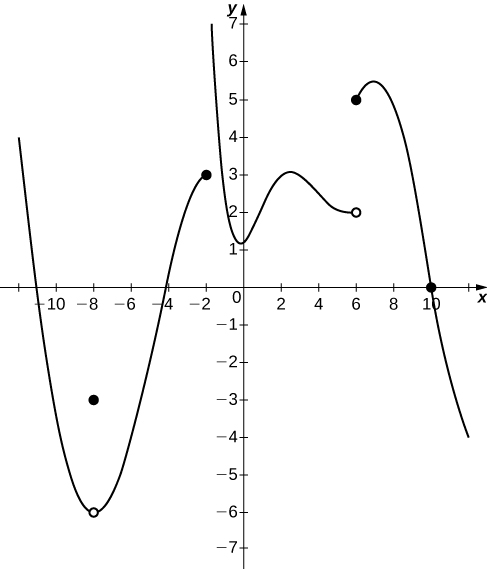
13. [latex]\underset{x\to 10}{\lim}f(x)=0[/latex]
14. [latex]\underset{x\to 2}{\lim}f(x)=3[/latex]
Answer:
True; [latex]\underset{x\to 2}{\lim}f(x)=3 [/latex]
15. [latex]\underset{x\to -8}{\lim}f(x)=f(-8)[/latex]
16. [latex]\underset{x\to 6}{\lim}f(x)=5[/latex]
Answer:
False; [latex]\underset{x\to 6}{\lim}f(x)[/latex] DNE since [latex]\underset{x\to 6^-}{\lim}f(x)=2[/latex] and [latex]\underset{x\to 6^+}{\lim}f(x)=5[/latex].
In the following exercises, use the following graph of the function [latex]y=f(x)[/latex] to find the values, if possible. Estimate when necessary.
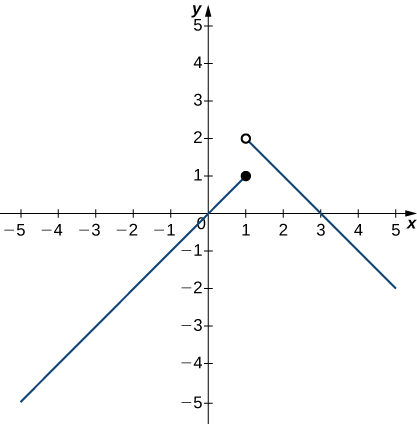
17. [latex]\underset{x\to 1}{\lim}f(x)[/latex]
18. [latex]\underset{x\to 2}{\lim}f(x)[/latex]
Answer:
1
19. [latex]f(1)[/latex]
In the following exercises, use the graph of the function [latex]y=f(x)[/latex] shown here to find the values, if possible. Estimate when necessary.
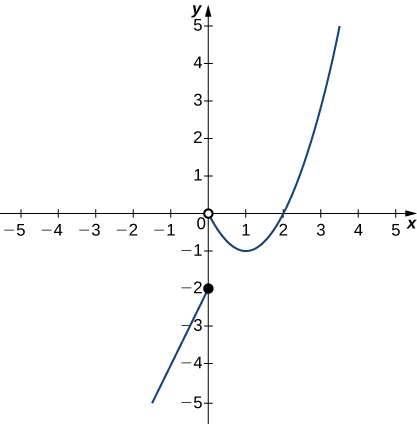
20. [latex]\underset{x\to 0}{\lim}f(x)[/latex]
Answer:
DNE
21. [latex]\underset{x\to 1}{\lim}f(x)[/latex]
22. [latex]\underset{x\to 2}{\lim}f(x)[/latex]
Answer:
0
23. [latex]\underset{x\to 3}{\lim}f(x)[/latex]
In the following exercises, use the limit laws to evaluate each limit. Justify each step by indicating the appropriate limit law(s).
24. [latex]\underset{x\to 0}{\lim}(4x^2-2x+3)[/latex]
Answer:
Use constant multiple law and difference law: [latex]\underset{x\to 0}{\lim}(4x^2-2x+3)=4\underset{x\to 0}{\lim}x^2-2\underset{x\to 0}{\lim}x+\underset{x\to 0}{\lim}3=3[/latex]
25. [latex]\underset{x\to 1}{\lim}\frac{x^3+3x^2+5}{4-7x}[/latex]
26. [latex]\underset{x\to -2}{\lim}\sqrt{x^2-6x+3}[/latex]
Answer:
Use root law: [latex]\underset{x\to -2}{\lim}\sqrt{x^2-6x+3}=\sqrt{\underset{x\to -2}{\lim}(x^2-6x+3)}=\sqrt{19}[/latex]
In the following exercises, use direct substitution to evaluate each limit.
28. [latex]\underset{x\to 7}{\lim}x^2[/latex]
Answer:
49
29. [latex]\underset{x\to -2}{\lim}(4x^2-1)[/latex]
30. [latex]\underset{x\to 0}{\lim}\frac{1}{1+ \sin x}[/latex]
Answer:
1
31. [latex]\underset{x\to 2}{\lim}e^{2x-x^2}[/latex]
32. [latex]\underset{x\to 1}{\lim}\frac{2-7x}{x+6}[/latex]
Answer:
[latex]-\frac{5}{7}[/latex]
33. [latex]\underset{x\to 3}{\lim}\ln e^{3x}[/latex]
In the following exercises, use direct substitution to show that each limit leads to the indeterminate form 0/0. Then, evaluate the limit.
34. [latex]\underset{x\to 4}{\lim}\frac{x^2-16}{x-4}[/latex]
Answer:
[latex]\underset{x\to 4}{\lim}\frac{x^2-16}{x-4}=\frac{16-16}{4-4}=\frac{0}{0}[/latex]; then, [latex]\underset{x\to 4}{\lim}\frac{x^2-16}{x-4}=\underset{x\to 4}{\lim}\frac{(x+4)(x-4)}{x-4}=8[/latex]
35. [latex]\underset{x\to 2}{\lim}\frac{x-2}{x^2-2x}[/latex]
36. [latex]\underset{x\to 6}{\lim}\frac{3x-18}{2x-12}[/latex]
Answer: [latex]\underset{x\to 6}{\lim}\frac{3x-18}{2x-12}=\frac{18-18}{12-12}=\frac{0}{0}[/latex]; then, [latex]\underset{x\to 6}{\lim}\frac{3x-18}{2x-12}=\underset{x\to 6}{\lim}\frac{3(x-6)}{2(x-6)}=\frac{3}{2}[/latex]
37. [latex]\underset{h\to 0}{\lim}\frac{(1+h)^2-1}{h}[/latex]
38. [latex]\underset{t\to 9}{\lim}\frac{t-9}{\sqrt{t}-3}[/latex]
Answer:
[latex]\underset{t \to 9}{\lim}\frac{t-9}{\sqrt{t}-3}=\frac{9-9}{3-3}=\frac{0}{0}[/latex]; then, [latex]\underset{t\to 9}{\lim}\frac{t-9}{\sqrt{t}-3}=\underset{t\to 9}{\lim}\frac{t-9}{\sqrt{t}-3}\frac{\sqrt{t}+3}{\sqrt{t}+3}=\underset{t\to 9}{\lim}(\sqrt{t}+3)=6[/latex]
39. [latex]\underset{h\to 0}{\lim}\frac{\frac{1}{a+h}-\frac{1}{a}}{h}[/latex], where [latex]a[/latex] is a real-valued constant
40. [latex]\underset{\theta \to \pi}{\lim}\frac{\sin \theta}{\tan \theta}[/latex]
Answer: [latex]\underset{\theta \to \pi}{\lim}\frac{\sin \theta}{\tan \theta}=\frac{\sin \pi}{\tan \pi}=\frac{0}{0}[/latex]; then, [latex]\underset{\theta \to \pi}{\lim}\frac{\sin \theta}{\tan \theta}=\underset{\theta \to \pi}{\lim}\frac{\sin \theta}{\frac{\sin \theta}{\cos \theta}}=\underset{\theta \to \pi}{\lim}\cos \theta =-1[/latex].
41. [latex]\underset{x\to 1}{\lim}\frac{x^3-1}{x^2-1}[/latex]
42. [latex]\underset{x\to 1/2}{\lim}\frac{2x^2+3x-2}{2x-1}[/latex]
Answer:
[latex]\underset{x\to 1/2}{\lim}\frac{2x^2+3x-2}{2x-1}=\frac{\frac{1}{2}+\frac{3}{2}-2}{1-1}=\frac{0}{0}[/latex]; then, [latex]\underset{x\to 1/2}{\lim}\frac{2x^2+3x-2}{2x-1}=\underset{x\to 1/2}{\lim}\frac{(2x-1)(x+2)}{2x-1}=\frac{5}{2}[/latex]
43. [latex]\underset{x\to -3}{\lim}\frac{\sqrt{x+4}-1}{x+3}[/latex]
In the following exercises, assume that [latex]\underset{x\to 6}{\lim}f(x)=4, \, \underset{x\to 6}{\lim}g(x)=9[/latex], and [latex]\underset{x\to 6}{\lim}h(x)=6[/latex]. Use these three facts and the limit laws to evaluate each limit.
44. [latex]\underset{x\to 6}{\lim}2f(x)g(x)[/latex]
Answer:
[latex]\underset{x\to 6}{\lim}2f(x)g(x)=2\underset{x\to 6}{\lim}f(x)\underset{x\to 6}{\lim}g(x)=72[/latex]
45. [latex]\underset{x\to 6}{\lim}\frac{g(x)-1}{f(x)}[/latex]
46. [latex]\underset{x\to 6}{\lim}(f(x)+\frac{1}{3}g(x))[/latex]
Answer:
[latex]\underset{x\to 6}{\lim}(f(x)+\frac{1}{3}g(x))=\underset{x\to 6}{\lim}f(x)+\frac{1}{3}\underset{x\to 6}{\lim}g(x)=7[/latex]
47. [latex]\underset{x\to 6}{\lim}\frac{(h(x))^3}{2}[/latex]
48. [latex]\underset{x\to 6}{\lim}\sqrt{g(x)-f(x)}[/latex]
Answer:
[latex]\underset{x\to 6}{\lim}\sqrt{g(x)-f(x)}=\sqrt{\underset{x\to 6}{\lim}g(x)-\underset{x\to 6}{\lim}f(x)}=\sqrt{5}[/latex]
49. [latex]\underset{x\to 6}{\lim}x \cdot h(x)[/latex]
50. [latex]\underset{x\to 6}{\lim}[(x+1)\cdot f(x)][/latex]
Answer: [latex]\underset{x\to 6}{\lim}[(x+1)\cdot f(x)]=(\underset{x\to 6}{\lim}(x+1))(\underset{x\to 6}{\lim}f(x))=28[/latex].
In the following exercises, use the following graphs and the limit laws to evaluate each limit.
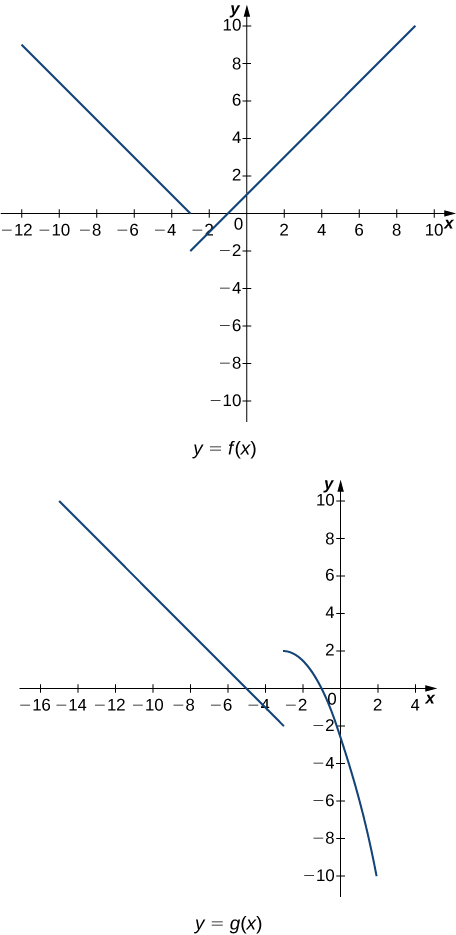
51. [latex]\underset{x\to 0}{\lim}\frac{f(x)g(x)}{3}[/latex]
52. [latex]\underset{x\to -5}{\lim}\frac{2+g(x)}{f(x)}[/latex]
Answer:
[latex]\underset{x\to -5}{\lim}\frac{2+g(x)}{f(x)}=\frac{2+(\underset{x\to -5}{\lim}g(x))}{\underset{x\to -5}{\lim}f(x)}=\frac{2+0}{2}=1[/latex]
53. [latex]\underset{x\to 1}{\lim}(f(x))^2[/latex]
54. [latex]\underset{x\to 1}{\lim}\sqrt{f(x)-g(x)}[/latex]
Answer: [latex-display]\underset{x\to 1}{\lim}\sqrt[3]{f(x)-g(x)}=\sqrt[3]{\underset{x\to 1}{\lim}f(x)-\underset{x\to 1}{\lim}g(x)}=\sqrt[3]{2+5}=\sqrt[3]{7}[/latex-display]
55. [latex]\underset{x\to -7}{\lim}(x \cdot g(x))[/latex]
Answer:
[latex]\underset{x\to -9}{\lim}(xf(x)+2g(x))=(\underset{x\to -9}{\lim}x)(\underset{x\to -9}{\lim}f(x))+2\underset{x\to -9}{\lim}(g(x))=(-9)(6)+2(4)=-46[/latex]
For the following problems, evaluate the limit using the Squeeze Theorem. Use a calculator to graph the functions [latex]f(x), \, g(x)[/latex], and [latex]h(x)[/latex] when possible.
57. [T] True or False? If [latex]2x-1\le g(x)\le x^2-2x+3[/latex], then [latex]\underset{x\to 2}{\lim}g(x)=0[/latex].
58. [T][latex]\underset{\theta \to 0}{\lim}\theta^2 \cos(\frac{1}{\theta})[/latex]
Answer:
The limit is zero.
![The graph of three functions over the domain [-1,1], colored red, green, and blue as follows: red: theta^2, green: theta^2 * cos (1/theta), and blue: - (theta^2). The red and blue functions open upwards and downwards respectively as parabolas with vertices at the origin. The green function is trapped between the two.](https://s3-us-west-2.amazonaws.com/courses-images/wp-content/uploads/sites/2332/2018/01/11203457/CNX_Calc_Figure_02_03_206.jpg)
59. [latex]\underset{x\to 0}{\lim}f(x)[/latex], where [latex]f(x)=\begin{cases} 0 & x \, \text{rational} \\ x^2 & x \, \text{irrational} \end{cases}[/latex]
Glossary
- infinite limit
- A function has an infinite limit at a point [latex]a[/latex] if it either increases or decreases without bound as it approaches [latex]a[/latex]
- intuitive definition of the limit
- If all values of the function [latex]f(x)[/latex] approach the real number [latex]L[/latex] as the values of [latex]x(\ne a)[/latex] approach [latex]a[/latex], [latex]f(x)[/latex] approaches [latex]L[/latex]
- one-sided limit
- A one-sided limit of a function is a limit taken from either the left or the right
- vertical asymptote
- A function has a vertical asymptote at [latex]x=a[/latex] if the limit as [latex]x[/latex] approaches [latex]a[/latex] from the right or left is infinite
Licenses & Attributions
CC licensed content, Shared previously
- Calculus I. Provided by: OpenStax Located at: https://openstax.org/books/calculus-volume-1/pages/1-introduction. License: CC BY-NC-SA: Attribution-NonCommercial-ShareAlike. License terms: Download for free at http://cnx.org/contents/[email protected].

Hint
Use 0.9, 0.99, 0.999, 0.9999, 0.99999 and 1.1, 1.01, 1.001, 1.0001, 1.00001 as your table values.